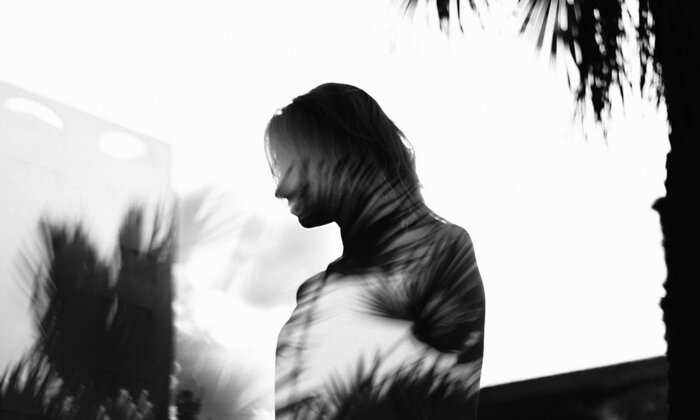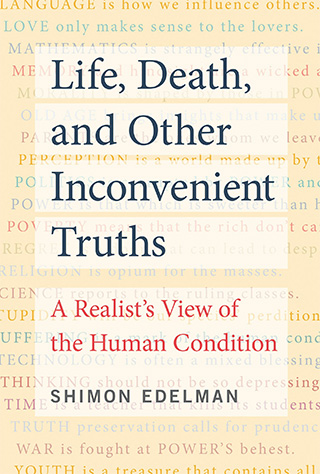Reality Is in the Eye of the Beholder

Things are not as they are seen, nor are they otherwise.
—”Laṅkāvatāra Sūtra”
It’s always night inside my skull — yours too, unless there are actual gaping holes in it. This proposition would be unremarkable, were it not for my visual experience, which often suggests otherwise. What it suggests right now, with me being awake and aware and my eyes open, is that the place from which I look out at the world is just behind the bridge of my nose. Even more strikingly, I see what I see through what appears to be a large oval hole in the front of my head. But when I feel around with my fingertips in search of it, I find that all is well with my face. This can only mean one thing: that the sensory reality that I inhabit is virtual. To put it less gently, I am living a lie.1

That the lie is being perpetrated by me on myself is something of a solace, as is the realization that it fits right into the bigger picture of what consciousness is. And I know I can — praise be to evolution — by and large trust my perception not to lead me into grave error, such as stepping off a cliff, or overlooking a pair of watchful eyes in tall grass, or otherwise messing with my chances of having and raising children. The perceived world is an illusion, but it is a useful one.
The predicament of the brain, confined to the perpetual darkness inside the skull, is, after all, not as dire as it sounds. The senses gather and make good use of enough information about what is happening on the outside to keep the virtual reality rig alive and kicking. If there is still any unease left, it comes from too much thinking, and too much worrying, about far-out things like ultimate truth. One such worry that arises out of thinking about perception is this: Given that everything we perceive is a virtual construct, how can we keep believing that our senses reveal to us the world as it really is?
Umwelten
The realization that the perceived world is virtual immediately leads to another one: that what it looks like should depend on the kind of virtual reality engine that one employs. Things are likely to look very different for species whose brain, body, and ecology all differ from the human “standard.” The same goes even for humans who happen to have special abilities. A useful, if fictional, prop for thinking about these matters is Zatōichi, the hero of a long-running action film series in Japan, whose prowess with a sword was not in the least impaired by his blindness. The trope, which the viewers loved, was that the Blind Swordsman leveled the playing field against sighted opponents by making better use of his remaining senses and his other skills. (He did not always play fair: In some fight scenes, he would first cut off the wicks of the candles, plunging everything into darkness.)
When a human and a dog go for a walk, the leash between them has each end in a different virtual world.
A key insight into Zatōichi’s situation is that light is of no use to him, nor is it even present as such in his perceptual world; and yet he acts as if the scene were brightly lit. Imagine this: Zatōichi and a sighted human walk into a barn. Make it a dark barn. Inside, the two of them meet a bat and an owl. There are now four qualitatively different kinds of perceptual worlds in play; five, if we count the mice scurrying on the floor; six, if the cat wanders in. Jakob von Uexküll, the ethologist who was among the first to realize the inevitable idiosyncrasy of each “lived world,” or Umwelt, remarked that “the dog is surrounded by dog things and the dragonfly is surrounded by dragonfly things.” When a human and a dog go for a walk, the leash between them has each end in a different virtual world.
How things really are
If different species, or even different individuals belonging to the same species, inhabit different perceptual worlds, what can we know about what the real world is like? Clearly enough to make action possible; apart from that, not much. Amazingly, the more basic a question about that real world seems, the more difficult it is to get a definitive answer to it. Is it dark at night? The sense in which it is for us is of little concern to a bat, and of no concern to a mole. Is air thick? Not really to us, but sufficiently so for a swallow to push against during its aerial acrobatics. Is water wet? Not to a duck or a water strider. In the face of such differences, it seems silly to insist that our perceptual world is somehow privileged or that what we perceive is how things really are.2
How things look and feel depends not only on who is doing the looking and feeling, but also on what action or other purpose it serves, as well as on the perceiver’s experiential history (and therefore on memory) and bodily and emotional state. I may see a rock outcropping encountered on a hike as a human face or as a battering ram, depending on where my mind was wandering as I was walking up to it (arguably, the best hiking experience requires that the hiker practice just seeing instead of seeing as).3
When I am hungry, a mountain track that I am facing looks steeper than right after a meal. The prospect of jumping at six o’clock in the morning into the indoor pool, in which the water is kept cool to prevent lap swimmers from overheating, feels discomforting to different degrees, depending on whether it is summer or winter outside, as I found out, having been doing this three times a week for many years. Luckily, it helps to think about other matters while swimming. For example, anticipating how the chapter that I am working on is going to end literally warms me up: It distracts me from the initial feeling of cold and I also swim faster, so that it takes me a couple of minutes less to do my usual 3,200 yards.
As we find ourselves compelled to doubt the very notion of objective truth about what the world is like, can science help? Yes, as long as we don’t expect it to do the impossible. Whatever the world is “really” like, evolution has been clearly successful — in an endless variety of strange and beautiful ways — in coming up with effective means of dealing with it. Science, which operates on much the same principles of variation and selection, can be at least equally successful. But evolution has no use for questions of ultimate truth and scientists too are supposed to shun them. In some disciplines, they have learned to do so. Is the electron really a wave or a particle? Quantum mechanics, an epitome of theoretical and practical success in physics, rightly refuses such questions.
The complexity of the human brain greatly exceeds that of any other physical system that we know of, so that in perception science it is even more important not to waste time on arguing about absolutes. What color is this banana? Purple (it’s my favorite variety from Costa Rica), but there is no matter of objective fact about this observation, because color has no physical definition: It is entirely the construct of the observer’s visual system in its interaction with the environment.4 At least as far as color is concerned, things are neither as they seem, nor otherwise.
There is a philosophical tradition out there that holds this — the essential emptiness of all things — to be an ultimate truth in its own right; indeed, the only ultimate truth. Some find this notion liberating — the religious tradition that is built around that philosophy holds this to be the only liberating notion. Others, like the reluctant hero of Ursula Le Guin’s “The Lathe of Heaven,” find it hard:
There is a bird in a poem by T. S. Eliot who says that mankind cannot bear very much reality; but the bird is mistaken. A man can endure the entire weight of the universe for eighty years. It is unreality that he cannot bear.
But now that we have seen it, bear it we must.
Shimon Edelman is Professor of Psychology at Cornell University. He is the author of several books including “The Consciousness Revolutions: From Amoeba Awareness to Human Emancipation” (Springer) and “Life, Death, and Other Inconvenient Truths: A Realist’s View of the Human Condition,” from which this article is excerpted.
- The hole-in-the-face eye-opening exercise appears in a 2013 article by neuroscientist Bjorn Merker’s in the context of his theory of the brain basis of consciousness. If you try it at home, make sure to protect your corneas.
- The inseparability of species-specific or rather Umwelt-specific perception and action has been stressed by ecological psychologists such as William Warren.
- The notion of “seeing as,” originally due to Ludwig Wittgenstein (“Philosophical Investigations,” 1958), has also been discussed by Douglas Hofstadter (“On Seeing A’s and Seeing As,” 1995). It is a key component of theories of visual perception and consciousness.
- The claim that perception cannot be objective is central to the Interface Theory. I have discussed some evolution-related qualifications to this theory elsewhere. This theory and the debate that surrounds it are very relevant to thinking.



